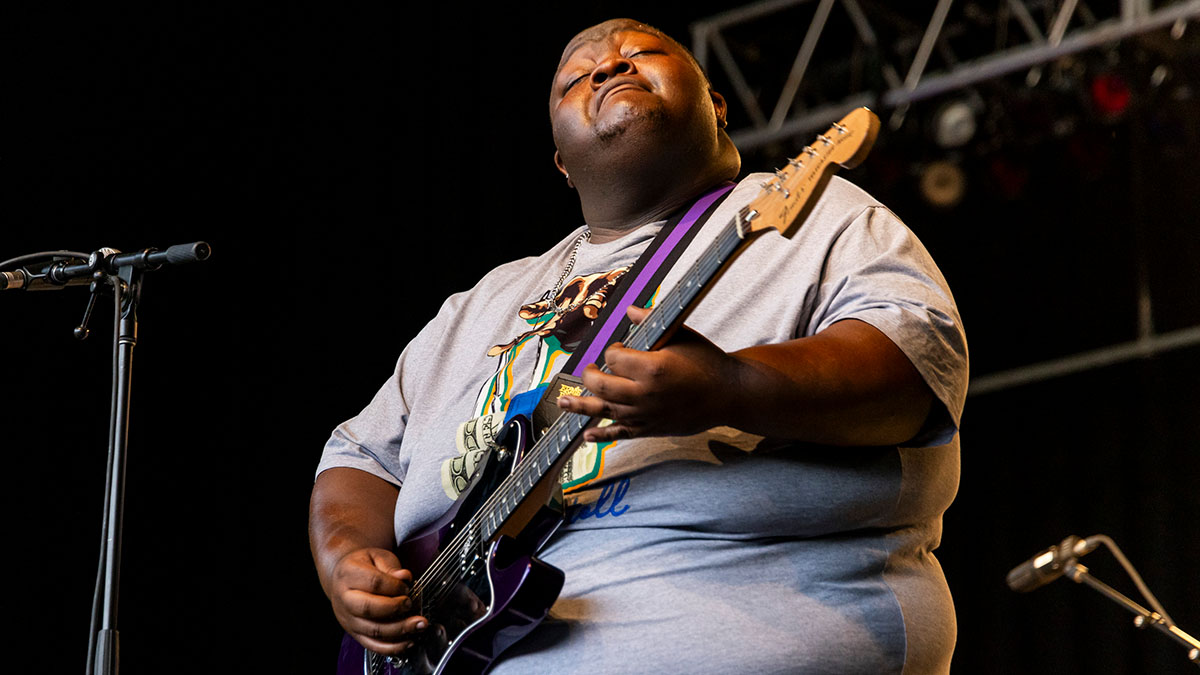
Kingfish hails from Clarksdale, Mississippi. Coincidentally (or not?), this is the location of the famous crossroads where legend has it that Robert Johnson traded his soul with the Devil in return for outlandish prowess on the guitar, and renown as a bluesman.
Ingram has assimilated much of the heritage of blues guitar and has formed a distinctive and extremely appealing personal style – not an easy thing to do in the crowded modern blues scene. Another aspect of his playing is the influence of sophisticated soul and funk music.
His harmonic language is peppered with interesting and uncommon note choices. He often mixes scales and modes over a vamp or a held chord in intros or outros. Over an intro on a minor 7 chord, he might alternate the Dorian and Aeolian modes with the minor pentatonic and blues scale.
This approach seems to make his lines sound extremely fluid and sophisticated. Add the use of classic blues phrases to this mix and you have a wide palette of approaches. Christone clearly does all this instinctively, just as his heroes did.
For reference, E Dorian is E-F#-G-A-B-C#-D, while E Aeolian is E-F#-G-A-B-C#-D. The one note that differs is the 6th degree – in Dorian it’s a major 6th, in Aeolian, the 6th is a minor interval – what a difference a semitone makes. You could say that the Aeolian is a darker sound.
Kingfish is not shy of some bold chromatic moves between scale tones, either. This adds a jazz-tinged quality to proceedings. One interesting move that he often likes to pull out is a semitone slide into the 9th degree of a minor 7th chord. For instance, on Em7, he will slide from the b9 (F Natural) to the major 9th (F#).
Christone’s delivery is hugely powerful. His bends and vibrato are often immense, and it will take work to match this level of attitude, but it will be worth it
If you’re not used to this way of thinking, we call this note the 9th because we’re viewing it as an extension of the chord. The 9th is the same note as the 2nd degree (usually an octave up) so as long as you can hear the sweet tension of this note against the underlying chord, the way you describe it is largely unimportant.
Stevie Ray Vaughan often hit the b9 as a momentary decoration in his blues licks. Kingfish uses this strategy in a slightly different way. Over Em7, it almost sounds like he’s stressing the 9th, followed by the b7 as a partial minor 9th arpeggio for a real jazz-influenced character.
Lastly, Christone’s delivery is hugely powerful. His bends and vibrato are often immense, and it will take work to match this level of attitude, but it will be worth it.
Get the tone
Amp Settings: Gain 7, Bass 7, Middle 4, Treble 6, Reverb 4
You could get close to Kingfish’s sound with any guitar. The two things that are important are his touch and that he uses a high-gain tone. He has said that Gary Moore was an influence whose lead tone was often very overdriven. You’ll need a high-gain overdrive pedal to push a clean amp into this territory. Reverb and delay would help to make the sound more expressive.
Example 1
Our first example exploits the E Dorian mode for a brighter colour, but at the end of the line there’s a bluesy sextuplet decoration.
Example 2
Here we’re using the 9th as an addition to the minor pentatonic and the six-note blues scale. This is a common strategy among modern blues players.
Example 3
Over moving chord changes you must be careful with your note choices, as you have to take account of the chord tones within the progression.
Example 4
This example uses various high bends. It’s mostly E minor pentatonic but we don’t sit on the 4th degree (A) too long, other than at the end of bar 2 for the A chord.
Example 5
This uses the slide from F to F# (bar 4, beat 1&) before playing a descending Gmaj7 arpeggio over Em. This adds variety to the minor pentatonic and blues scale lines.
Final solo
Our sample solo combines the example licks with embellishments to make one line flow nicely to the next. Listen to the audio and watch the video if reading the rhythm looks tricky. There is a logic to these rhythms that might be more obvious if you know the sound you’re aiming for.







